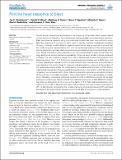Porcine head response to blast
Author(s)
Nyein, Michelle K.; Shridharani, Jay K.; Wood, Garrett W.; Panzer, Matthew B.; Capehart, Bruce P.; Bass, Cameron R. ‘Dale’; Radovitzky, Raul A; ... Show more Show less
DownloadShridharani-2012-Porcine head respons.pdf (3.283Mb)
PUBLISHER_POLICY
Publisher Policy
Article is made available in accordance with the publisher's policy and may be subject to US copyright law. Please refer to the publisher's site for terms of use.
Terms of use
Metadata
Show full item recordAbstract
Recent studies have shown an increase in the frequency of traumatic brain injuries related to blast exposure. However, the mechanisms that cause blast neurotrauma are unknown. Blast neurotrauma research using computational models has been one method to elucidate that response of the brain in blast, and to identify possible mechanical correlates of injury. However, model validation against experimental data is required to ensure that the model output is representative of in vivo biomechanical response. This study exposes porcine subjects to primary blast overpressures generated using a compressed-gas shock tube. Shock tube blasts were directed to the unprotected head of each animal while the lungs and thorax were protected using ballistic protective vests similar to those employed in theater. The test conditions ranged from 110 to 740 kPa peak incident overpressure with scaled durations from 1.3 to 6.9 ms and correspond approximately with a 50% injury risk for brain bleeding and apnea in a ferret model scaled to porcine exposure. Instrumentation was placed on the porcine head to measure bulk acceleration, pressure at the surface of the head, and pressure inside the cranial cavity. Immediately after the blast, 5 of the 20 animals tested were apneic. Three subjects recovered without intervention within 30 s and the remaining two recovered within 8 min following respiratory assistance and administration of the respiratory stimulant doxapram. Gross examination of the brain revealed no indication of bleeding. Intracranial pressures ranged from 80 to 390 kPa as a result of the blast and were notably lower than the shock tube reflected pressures of 300–2830 kPa, indicating pressure attenuation by the skull up to a factor of 8.4. Peak head accelerations were measured from 385 to 3845 G’s and were well correlated with peak incident overpressure (R[superscript 2] = 0.90). One SD corridors for the surface pressure, intracranial pressure (ICP), and head acceleration are presented to provide experimental data for computer model validation.
Date issued
2012-05Department
Massachusetts Institute of Technology. Institute for Soldier Nanotechnologies; Massachusetts Institute of Technology. Department of Aeronautics and AstronauticsJournal
Frontiers in Neurology
Publisher
Frontiers Research Foundation
Citation
Shridharani, Jay K. et al. “Porcine Head Response to Blast.” Frontiers in Neurology 3 (2012). © 2012 Frontiers Media S.A.
Version: Final published version
ISSN
1664-2295